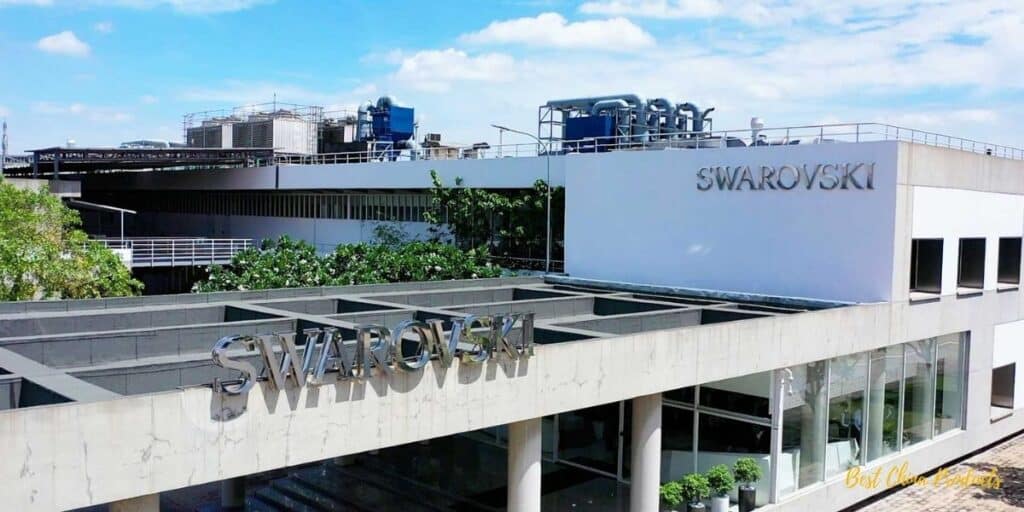Swarovski crystals have long been synonymous with elegance and opulence, gracing everything from haute-couture runways to exquisite home decor.
But have you ever wondered where is Swarovski Crystal made? In this article, we embark on a journey to uncover the heart of Swarovski's craftsmanship - the very place where these iconic crystals come to life.
From its humble beginnings in the picturesque town of Wattens, Austria, to its global influence, we delve into the artistry and precision that define the production of Swarovski crystal.
So read on to learn where Swarovski crystals are made.
Also check out: Where Are Bulova Watches Made?
Where is Swarovski Crystal Made?

So, Where is Swarovski Crystal Made? Swarovski crystals are made in Austria, in the town of Wattens, Tyrol. The company has a number of other production facilities around the world, but the main production facility is still in Wattens.
The Swarovski crystal factory in Wattens was founded in 1892 by Daniel Swarovski. The factory is located in a valley surrounded by the Alps, and the water from the mountains is used to power the factory's machinery.
Swarovski crystals are made from a special type of glass that is known for its clarity and sparkle. The glass is melted at high temperatures and then drawn into long rods. The rods are then cut into small pieces, which are then polished and faceted.
Is Swarovski Crystal Made in China?

Yes, Swarovski does make jewelry in China. The company has a number of production facilities in China, including factories in Dongguan, Shenzhen, and Suzhou. The jewelry made in China is typically assembled from components that are made in Austria, China, and other countries.
The reason why Swarovski makes jewelry in China is because of the lower labor costs in China. The company is able to produce jewelry at a lower cost in China, which allows them to offer it at a lower price to consumers.
However, it is important to note that the crystals used in Swarovski jewelry are still made in Austria. The crystals are shipped to China where they are assembled into jewelry.
So, if you are looking for Swarovski jewelry that is made entirely in Austria, you will need to look for jewelry that is labeled "Made in Austria". Jewelry that is labeled "Made in China" or "Made in China with Swarovski Crystals" means that the jewelry was assembled in China, but the crystals were made in Austria.
How long does it take for Swarovski to manufacture their crystals?

Manufacturing Swarovski crystals is a meticulous process that spans approximately 2-3 weeks.
It commences with the fusion of quartz sand, soda, potash, and other elements at elevated temperatures.
The resulting molten glass is shaped into extended rods, subsequently sectioned into smaller fragments, and then refined and faceted to achieve the signature radiance of Swarovski crystals.
For a comprehensive understanding, let's break down the intricate steps involved in crafting Swarovski crystals:
- Melting: The initial stage entails subjecting a blend of quartz sand, soda, potash, and additional components to high-temperature melting within a furnace, which can achieve remarkable temperatures of up to 1,450 degrees Celsius (2,640 degrees Fahrenheit).
- Drawing: Post-melting, the glass material is drawn into elongated rods, a process achieved by passing the molten glass through specialized dies that shape it to the desired form.
- Cutting: Subsequently, the rods undergo precision cutting into smaller segments. This task is performed by a machine utilizing a diamond wire to precisely divide the glass.
- Polishing: The cut fragments are then subjected to a meticulous polishing process aimed at eliminating any rough edges. A specialized machine, equipped with a rotating wheel covered in a polishing compound, executes this task.
- Faceting: To impart the distinct sparkle characteristic of Swarovski crystals, the polished pieces undergo a faceting process. This step is executed by a machine equipped with a diamond wheel that intricately carves the glass into small, glistening facets.
The Swarovski crystal manufacturing process demands exactitude and consumes considerable time. This dedication to precision is the foundation of Swarovski crystals' esteemed reputation for exceptional quality and enduring durability.
Who Owns Swarovski?

Swarovski is privately owned by the Swarovski family. The company was founded in 1895 by Daniel Swarovski, who invented an electric crystal-cutting machine. The company is now run by the fifth generation of the Swarovski family.
Swarovski is headquartered in Wattens, Austria. The company has over 27,000 employees and operates over 2,800 stores in around 170 countries. The company's products include jewelry, fashion accessories, home décor, and lighting.
Does Swarovski use Genuine Crystals?

Swarovski crystals are not actually natural crystals. They are man-made crystals that are made from a mixture of quartz sand, soda, potash, and other ingredients. The crystals are then cut and polished to create the characteristic sparkle of Swarovski crystals.
Swarovski crystals are made using a patented process that ensures that they are of the highest quality. The crystals are also very durable and can withstand everyday wear and tear.
While Swarovski crystals are not natural crystals, they are still considered to be high-quality crystals. They are used by some of the world's leading fashion designers and jewelers, and they are known for their sparkle and brilliance.
Is Swarovski made in Vietnam?

Yes, Swarovski does have a manufacturing facility in Vietnam. The company has a number of production facilities around the world, and Vietnam is one of the countries where they manufacture jewelry and fashion accessories.
The Swarovski Manufacturing Vietnam LLC is located in Binh Duong Province, Vietnam. The factory employs over 2,000 people and produces a variety of products, including earrings, necklaces, bracelets, and watches.
The decision to manufacture products in Vietnam was made due to the favorable business environment in the country. Vietnam has a low-cost workforce and a good infrastructure, which makes it a good place to manufacture products.
Why are Swarovski Crystals so Expensive?
Swarovski crystals are expensive for a number of reasons:
- They are made from a high-quality mixture of quartz sand, soda, potash, and other ingredients. This ensures that the crystals are clear, brilliant, and durable.
- Swarovski crystals are cut using a precise process that ensures that they have the correct number and size of facets. This is what gives Swarovski crystals their characteristic sparkle.
- It is a well-known and respected brand. This means that consumers are willing to pay a premium for Swarovski crystals.
- Swarovski crystals are not mass-produced. This means that they are more difficult to find and therefore more expensive.
Where is Swarovski Crystal Made - Conclusion
In conclusion, the story of Swarovski crystal production is one of meticulous artistry and unwavering dedication.
From its inception in the enchanting town of Wattens, Austria, to its global presence, the legacy of Swarovski is deeply rooted in a commitment to excellence.
The intricate process, spanning weeks of precise craftsmanship, results in the breathtaking crystals that have adorned the world's most exquisite creations.
As we've discovered, the journey begins with a fusion of raw materials, culminating in the creation of molten glass that is carefully shaped, cut, polished, and faceted.
This attention to detail, coupled with state-of-the-art technology, ensures the hallmark sparkle and enduring quality that define Swarovski crystals.
Related






